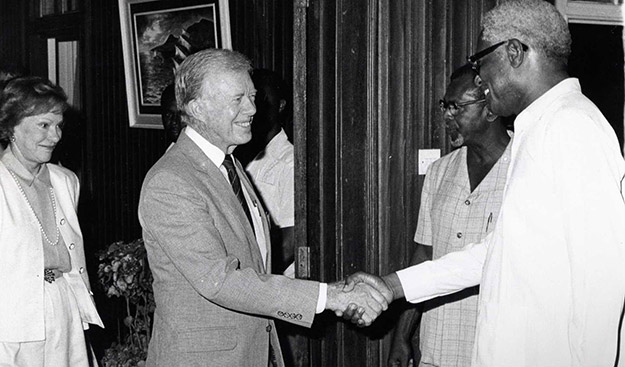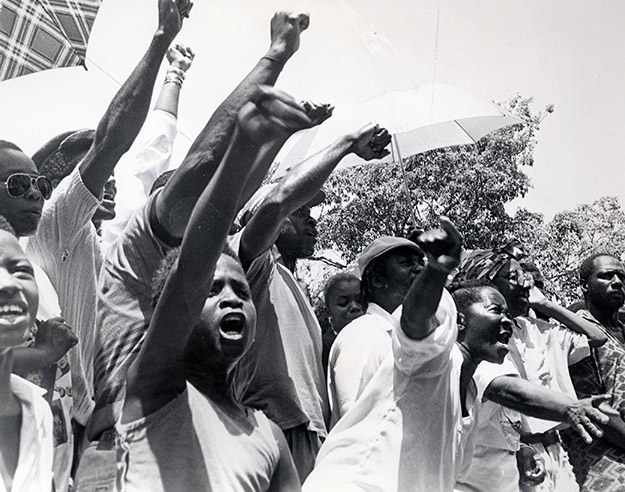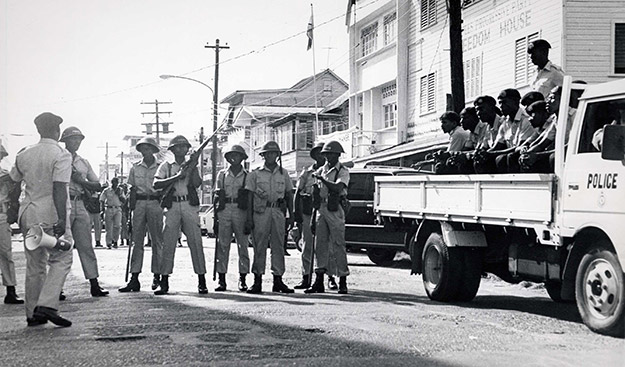In 2007, former U.S. President Jimmy Carter wrote "Beyond the White House," about his post-presidency work with The Carter Center. In it, he reflected on a number of election observation missions, including the Center's first to Guyana, in 1992. An excerpt from the book, published by Simon and Schuster, is reprinted here.
The most personal danger I have felt since leaving the White House was in Guyana in 1992. This small nation on the northern coast of South America was then and still is the most completely divided that I know. About 9 percent of its citizens are Amerindians living mostly in the vast forests, and another 80 percent are divided between descendants of indentured servants from India and descendants of African slaves, both brought in by the British during colonial times. The major political parties are largely separated along these racial lines, as are many of the basic professions.
The Indo-Guyanese hold a slight majority, but the Afro-Guyanese and their People's National Congress (PNC) party were able to control the government from the time of national independence in 1966, assisted by the government of Great Britain and the CIA, both of which considered Cheddi Jagan, leader of the opposition People's Progressive Party (PPP), to be a Marxist.

President Desmond Hoyte welcomed President and Mrs. Carter during a visit to Guyana in October 1990. (Photo: The Carter Center/K. Moore)
In 1990, Mr. Jagan came to The Carter Center, claimed that previous elections had been fraudulent, and asked us to help ensure that the next one would be honest and fair. We agreed, provided the ruling party would also accept our presence as observers. For several months, President Desmond Hoyte objected strongly, but public opinion became so greatly aroused that he finally agreed, just one month before the election was scheduled. Bob Pastor and his team developed a list of minimal election standards, and I went to Guyana to discuss them with the president and others. Three of the most important were to have an accurate voters' list, a politically balanced election commission, and votes counted at the polling places.
These issues had been hotly debated for almost thirty years and were very difficult for the ruling party to accept. Finally, as I was preparing to leave the country and declare that we could not participate, President Hoyte accepted all our provisions. The election was delayed until October 1992, and government officials also invited observers of the British Commonwealth, with whom they had enjoyed a close and friendly relationship.
As usual, we deployed our two-person teams throughout the country before Election Day, and I went west along the coast toward the border with Venezuela to visit a few polling sites in a riverine area inhabited by Arawak Indians, traveling from one village to another in a small boat. On the way back to Georgetown, the capital, we flew over the famous site of the 1978 mass suicide of Jim Jones and more than nine hundred of his cult followers. When we arrived at the airport, our small plane was surrounded by members of the security forces, who informed me that riots had broken out all over Georgetown, and that I must go to the U.S. Embassy, where I would be safe.

The day-long siege of the Elections Commission headquarters in Georgetown by a violent and angry crowd claiming they were not allowed to vote nearly caused Guyana's elections to collapse. (Photo courtesy of Guyana Chronicle)
Instead, I went to my hotel room and called President Hoyte, who assured me that the police were in charge and order would soon be restored. Bob Pastor informed me that the PNC were obviously losing the election, and that some of their supporters had been induced to disrupt the process. I decided that the election should continue if possible and sent word to our observers to monitor events and, after the polls closed, to go to their assigned places to gather quick count results. Our senior observer, Jennifer McCoy, told me that the election center had come under attack by an angry mob, some of whom claimed to have been denied a ballot. She had visited the building and tried to work out a solution with the PNC party chief, but the riot continued.

Police cordoned off Robb Street in Georgetown, Guyana, after dispersing a stone-throwing crowd in front of the Freedom House, headquarters of the People's Progressive Party. (Photo courtesy of Guyana Chronicle)
The election center was where all of the communication equipment and computers, on which election results would be tabulated, were located. It was a two-story wooden building with many windows, with the electronic equipment housed in an isolated central room on the second floor. When I arrived, accompanied by three Secret Service agents, the building was surrounded by several hundred rioters, who had already broken all the windows with clubs and stones. There was only one Guyanese police office present, a woman wearing a uniform but without sidearms.
We went upstairs and found that all the computers had been transferred to one of the more isolated hotels for safekeeping. I phoned the hotel manager, who told me that the computers could not be operated there unless "a battalion of troops is sent to protect us against the mobs trying to stop the vote count." I called the president again. I told him that I was in the unprotected building and that there was no way to complete the election unless the workers could return with their computers. Also, I told him that our Secret Service would contact the White House if I didn't receive immediate protection from the mob outside.
Calm was restored after another hour, and the computers were tabulating returns by midnight. Our quick count showed that the ruling party would lose by about 14 percent, and early the next morning I went to visit both presidential candidates. They agreed to refrain from any public statements and to accept the final results, which were announced three days later. Cheddi Jagan was sworn in as president after what was considered to be the country's first free and fair election since independence. After his death five years later, his wife, Janet Jagan, became president, but she resigned in 1999 because of poor health.
The Carter Center has remained in close contact with the people of Guyana and has helped them to work out a long-range plan for economic and political development. A young deputy finance minister, Bharrat Jagdeo, was assigned by the Jagans to work with us on this project, and he performed this duty superbly. When Mrs. Jagan became ill, Jagdeo was chosen to succeed her as president, and he was elected and then reelected in 2001 and 2006. Unfortunately, many of the divisions in Guyana remain.
Related Resources
Please sign up below for important news about the work of The Carter Center and special event invitations.